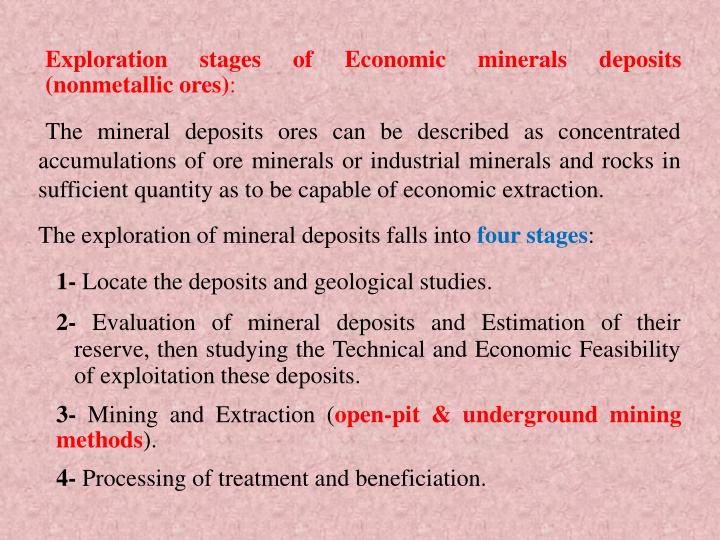
Exploration and Mining of Nonmetallic Ores: Stages and Operations
Explore the stages of economic mineral deposits, from locating geological studies to processing and beneficiation. Learn about the different mining operations, including underground, surface, alluvial, and non-entry mining methods for extracting valuable minerals from the earth's crust.
Download Presentation

Please find below an Image/Link to download the presentation.
The content on the website is provided AS IS for your information and personal use only. It may not be sold, licensed, or shared on other websites without obtaining consent from the author. If you encounter any issues during the download, it is possible that the publisher has removed the file from their server.
You are allowed to download the files provided on this website for personal or commercial use, subject to the condition that they are used lawfully. All files are the property of their respective owners.
The content on the website is provided AS IS for your information and personal use only. It may not be sold, licensed, or shared on other websites without obtaining consent from the author.
E N D
Presentation Transcript
Exploration (nonmetallic ores): stages of Economic minerals deposits The mineral deposits ores can be described as concentrated accumulations of ore minerals or industrial minerals and rocks in sufficient quantity as to be capable of economic extraction. The exploration of mineral deposits falls into four stages: 1- Locate the deposits and geological studies. 2- Evaluation of mineral deposits and Estimation of their reserve, then studying the Technical and Economic Feasibility of exploitation these deposits. 3- Mining and Extraction (open-pit & underground mining methods). 4- Processing of treatment and beneficiation.
Mining operations: Minerals may be mined and processed for more than one purpose. The mineral may be a metal ore, when it is used to prepare the metal, as when bauxite (hydrated aluminium oxide) is used to make aluminium. The mineral is classified as a nonmetallic ore when bauxite is used to make material for refractory bricks or abrasives. Mining is the process of extracting minerals of economic value from the earth s crust for the benefit of mankind. A mine is an excavation made in the earth for the purpose of extracting useful minerals.
four main classes The (Gregory, 1980): of mining operations 1- Underground mining: (ore is far from surface & the covered rocks are hard & thick) Near vertical vein deposits, Horizontal bedded deposits (metals, nonmetals) 2- Surface (open-pit) mining: (ore is near from surface, the covered rocks are soft & thin) Quarrying of construction (building) stones Mining of metals & nonmetals
3- Alluvial mining: (for alluvial deposits & heavy minerals) Beach dunes, Stream beds & terraces 4- Non-entry mining: Solution mining of copper Frasch process for sulphur Oil wells (petroleum, natural gas, water)
